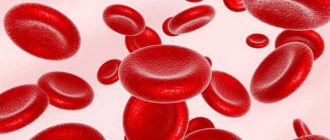If previously laboratories determined only the level of platelets, today they examine much more indicators of the platelet germ in the blood. First of all, this is the average platelet volume, which is automatically calculated by special devices. The results they produce do not look entirely standard and are represented by two or three letters of the Latin alphabet. Not even all specialists are yet familiar with them, not to mention patients who cannot understand anything at all about the results obtained.
What is this indicator and what is its norm?
It is important to understand that conditions in which the level of platelets is elevated and cases in which a high average platelet volume is recorded are far from the same thing. In the first case, they talk about thrombocytosis, which indicates an increase in the number of platelet cells per unit volume of blood without describing their qualitative characteristics. The average platelet volume indicator, on the contrary, does not indicate the quantitative characteristics of these blood elements, but partially indicates their type. By its size one can judge the usefulness of platelets. This means that mature platelet cells, being smaller in size, occupy less volume in a certain amount of blood. Immature cells of the megakaryocyte lineage are distinguished by their structureless structure, large size, and therefore occupy much more space in a limited blood volume.
An increase in the average platelet volume indicates the presence of immature forms of these cellular elements in its composition. The more such a deviation from the norm is determined, the more platelet cells are defective. The result of this indicator can be determined by evaluating the numbers in a hardware blood test under the abbreviation MPV. Standards for the average platelet volume range from 7.0 to 11.0 femtoliter (Fl).
Is there a danger in increasing the number of platelets in the blood?
Definitely yes, since elevated platelets in the blood are one of the signs of the development of a pathological process in the human body. Therefore, if consistently elevated values are detected in a blood test, you should undergo a comprehensive diagnosis. Based on the results of the examination, the doctor will be able to understand whether thrombocytosis is primary or secondary. Based on the cause of the pathology, appropriate treatment is selected.
Complications of a high level of platelets in the blood can include blood clots in blood vessels, heart attacks, strokes, kidney damage, thrombophlebitis of the veins of the lower extremities, etc.
Additional diagnostic methods to determine the form of thrombocytosis:
- clinical blood test with an expanded leukocyte formula. It is known that with primary thrombocytosis, the value of the indicator reaches critical values, up to 1 million cells in 1 microliter of the biomaterial being studied. This is not typical for the reactive form. Also, in the primary form, the content of all blood cells changes upward; the deviation parameters for secondary thrombocytosis directly depend on the underlying pathology;
- determination of erythrocyte sedimentation rate, since it increases during inflammatory processes, which indicates secondary thrombocytosis;
- ferritin test. The protein content in the blood decreases with iron deficiency anemia, which causes a reactive form;
- genetic studies will reveal the presence of mutations in genes characteristic of primary thrombocytosis;
- extended coagulogram;
- blood chemistry.
The patient may also be advised to undergo a bone marrow biopsy. This will allow not only to differentiate the form of thrombocytosis, but also to diagnose malignant diseases. To exclude internal bleeding, an ultrasound examination is performed.
It is noted that thrombocytosis at an early stage does not manifest itself in the form of clinical symptoms, so an annual preventive examination should not be neglected. This is of particular importance for people over 60 years of age and children, patients with iron deficiency anemia and cancer, as well as for people after operations or serious injuries.
Symptoms of severe thrombocytosis may be ischemia of the lower extremities (coldness of the legs, cramps, poor healing of wounds on the legs, pain in the legs when walking, etc.), arrhythmias, coronary heart disease (shortness of breath, weakness, heart rhythm disturbances), dizziness, etc. .d.
- Eosinophils are elevated in an adult - what does this mean, normal levels in the blood, reasons for the increase
In what cases is an increase in the indicator a variant of the norm?
Sometimes the distribution of platelets by blood volume is within the limits bordering the upper standard value or slightly exceeds it. This does not always indicate pathology and is evidence of physiological abnormalities in the body. This is possible in the following cases:
- In young children, due to inadequate hematopoiesis, which can cause the release of immature platelets into the blood;
- In the postoperative period during complex and bloody interventions;
- After massive and multiple injuries;
- In the period after menstruation, especially heavy ones;
- After suffering internal and other types of bleeding;
- After using agents that stimulate hematopoietic processes.
In all these situations, there is an increased release of platelets from the bone marrow, which is compensatory in nature and is intended to stop blood loss. Naturally, under such conditions, immature cells from a number of megakaryocytes also appear among the full-fledged cells. If the average platelet volume in severe acute and chronic blood loss is not increased, this indicates the failure of the platelet germ in the blood and bone marrow.
How to increase?
When looking for ways to increase platelets in the blood, one should not forget the main thing - self-medication can be life-threatening. Medicines used to urgently increase thrombotic mass have a lot of side effects and should not be used without a doctor's prescription.
- Platelets are elevated in an adult - what does this mean, and how to reduce them?
If platelets are low due to medications (aspirin, etc.), you should stop using them.
There are no products that can effectively affect platelets if they are low, nor any folk remedies. These drugs can only be used as auxiliary, but not the main methods of increasing platelets.
The main way to eliminate pathological thrombocytopenia is to treat the disease that led to it.
An increase in indicator as an alarm signal
An abnormal average platelet volume in the form of an increase is a symptom of many diseases. Its detection may be the first step towards their diagnosis. The degree of increase in the indicator can be used as one of the criteria for assessing the dynamics of the pathological process and the effectiveness of treatment measures. This is possible with:
- Thrombocytopenia associated with accelerated platelet destruction;
- Hypersplenism and enlarged spleen;
- Diabetes mellitus;
- Widespread vascular atherosclerosis;
- Thyrotoxicosis (increased thyroid function);
- Myeloid leukemia, erythremia and other blood diseases accompanied by increased myeloproliferative processes;
- Bernard-Soulier macrocytic platelet dystrophy (an abnormality in the synthesis of platelet cells, in which each mature cell has an irregular shape and size);
- May-Hegglin anomalies (a genetic disease manifested by a decrease in the number of platelets and their inferiority);
- Malicious abuse of alcoholic beverages and smoking.
Determining the average platelet volume is only possible when testing blood using an automatic laboratory analyzer
Reasons for decreased average platelet volume
The main causes of pathology include the following:
- hypoplasia of the megalocaryocyte lineage (congenital pathology and acquired disease (this group of megalocaryocyte hypoplasias also includes aplastic anemia);
- X-linked recessive thrombocytopenia with platelet microcytosis (Wiskott-Aldrich syndrome);
- sepsis (for example, with septic endocarditis);
- myelodysplastic syndrome;
- development of malignant cancerous tumors, including in the bone marrow;
- inflammatory diseases;
- infectious diseases (measles, rubella, influenza) in children;
- myocardial infarction;
- some kidney diseases;
- severe damage to the liver parenchyma (cirrhosis);
- chemotherapy;
- irradiation;
- cytostatic therapy;
What cells does blood consist of?
- taking certain medications;
- pathology of pregnancy, indicating a possible miscarriage.
Characteristics of platelets
Attention! The exact cause of the pathology can only be identified by the attending physician after a full examination and assessment of the patient’s general condition using tests, ultrasound and other necessary studies.
Parallels with platelet level
There is a clear correlation between the number of platelet cells in the blood and their average volume. Usually it is represented by an inversely proportional relationship: the more the platelet level increases, the lower their average volume. And, conversely, an increase in the average cell volume is accompanied by a decrease in their number in the blood. But this doesn't always happen:
- With myeloproliferative processes (pancytopenia, erythremia, thrombocytosis). In such cases, both one and the second indicator are simultaneously increased due to the release of an equal number of mature and immature forms of platelets into the blood;
- In conditions after bleeding or any blood loss (trauma, surgery, menstruation), both indicators are higher than normal;
- Synchronous decrease in platelets and their average volume. It is evidence of hypo- or aplasia of the bone marrow, when it is potentially unable to respond by producing young cells to a decrease in their level in the body.
Platelets
Platelets are the third and last formed elements of blood studied during a general blood test, but in terms of their importance for human health and vital activity they are far from in last place. Platelets, or platelets, are tiny (2-4 microns), flattened, anucleate cells with an uneven surface. They are produced by the bone marrow and perform important functions: they form the primary plug at sites of damaged blood vessels, provide their surface for the plasma coagulation reaction, and then release growth factors that promote wound healing and tissue regeneration.
Total platelet count (PLT)
Platelet rate:
- Women and men – 180-320 109/l
- Children – 160-400 109/l
A pronounced decrease in the content of platelets in the blood when deciphering the results of a general analysis indicates a high risk of prolonged bleeding and extensive blood loss if a person receives a serious injury. And a pathological increase in their number can lead to the formation of blood clots (thrombi) blocking blood vessels, which is also very dangerous.
Platelet deficiency is collectively called thrombocytopathy. It is of three types: a decrease in the number of cells (thrombocytopenia), an abnormal increase (thrombocytosis) and a violation of their functional activity (thrombasthenia).
Platelets are elevated – reasons:
- Blood loss due to injury, childbirth or surgery;
- Iron-deficiency anemia;
- Acute inflammatory process or exacerbation of a chronic disease, for example, rheumatism;
- Splenectomy;
- Oncological diseases;
- Erythremia;
- Exhaustion or extreme fatigue.
Platelets are low – reasons:
- Hemophilia (congenital bleeding disorder);
- Aplastic anemia;
- Systemic lupus erythematosus;
- Autoimmune thrombocytopenic purpura;
- Some viral, bacterial and parasitic infections, such as malaria or toxoplasmosis;
- Heart failure;
- Paroxysmal nocturnal hemoglobinuria;
- Evans syndrome and DIC syndrome;
- Renal vein thrombosis;
- The period after blood transfusion;
- Prematurity in infants;
- Taking blood thinning medications such as aspirin.
Platelet indices (MPV, PDW, PCT)
The automatic analyzer calculates three platelet indices based on information about the total content of blood platelets, their sizes and volumes. These indicators in the decoding of a general blood test are designated by abbreviations consisting of several Latin letters.
MPV (mean platelet volume)
This index characterizes the average volume of one platelet and is expressed in femtoliters. It is known that very young platelets are large in size and do not work efficiently enough, while old ones shrink and gradually lose their functionality. This means that if a person has an increased MPV, his blood clotting is impaired, and if it is low, the bone marrow produces too few new platelets.
MPV rate:
- Women and men – 7.0-10.0 fl
- Children – 7.4-10.4 fl
PDW (platelet distribution width)
This index reflects the degree to which platelets differ from each other in volume, or their anisocytosis, and is measured as a percentage. We have already considered a similar indicator when we talked about red blood cells. In the case of platelets, it is also very important to take into account the previous index, MPV, when assessing the PDW value, because this is the only way to objectively judge the condition and functionality of the blood platelets.
PDW standard:
- Women and men – 15-17%
- Children – 10-17%
PCT (platelet crit)
This index is otherwise called thrombocrit, is an analogue of hematocrit, is also expressed as a percentage and describes the ratio of platelet volume to total blood volume. If the reading is significantly lower than normal, this may indicate temporary clotting problems or even hemophilia. If the thrombocrit is higher than normal, a person is at risk of forming clots and clogging blood vessels.
PCT Standard:
- Women and men – 0.1-0.4%
- Children – 0.15-0.4%
Head of Clinical Diagnostic Laboratory
Institution "6th Central Regional Communal Center of the Leninsky District of Minsk" - Veysaga Chungara Umberto
What to do if you detect an increase in the indicator
Under no circumstances should you independently interpret any test results. A single detection of the average platelet volume indicator, which is elevated, does not mean anything. A parallel assessment of other parameters of the blood being tested must be carried out. Only a doctor can do this fully. Usually, re-examination is recommended. Depending on the results obtained and the presence of deviations from the norm during examination of the patient, the data obtained are interpreted. Only after this the necessary medication correction is prescribed.
Interesting video:
The average platelet volume, as one of the indicators of a general automated blood test, is an excellent guide to the qualitative characteristics of these cellular elements. It reflects the ability of platelets to perform their functions in maintaining blood viscosity and the integrity of the vascular bed. In most cases, an increase in this indicator indicates the presence of gross pathology in the body, especially when combined with a drop in platelet count, and requires consultation with a hematologist.
Diagnostics
Since there are so many reasons, it is not possible to name diagnostic measures in detail - everything will depend on the specific situation. But we can highlight the main components of diagnosis:
- General blood analysis.
- Checking bleeding time (Duke test).
- Determining the time it takes for blood to clot.
- Red bone marrow puncture. The method allows you to identify quantitative and qualitative changes in cells.
- Determination of antibodies in blood.
- Research for genetic diseases.
- Ultrasound of internal organs. Most often, the liver and spleen are studied immediately, but this list can be very large.
- MRI. Used to study internal organs and blood vessels.
Diagnosis of the disease begins with a visit to a general practitioner, who, based on a survey, initial examinations and tests, prescribes visits to other specialists.
Preparation and delivery of a general blood test
To take a general blood test, standard preparation rules are used. Blood sampling is carried out in the morning on an empty stomach. On the eve of the study, you should avoid excessive physical and mental stress, and give up fatty foods. Before donating blood, you should not smoke; the patient should be completely at rest for half an hour before the test. Blood for general analysis can be taken either from a finger or from a vein.
Determination of MPV in a general blood test is carried out within two hours after collecting the material, since with a later study the result may be distorted.
A decrease in MPV may mean an enlarged spleen (splenomegaly), the presence of liver cirrhosis, hypoproteinemia, kidney disease, and thyroid pathologies.










